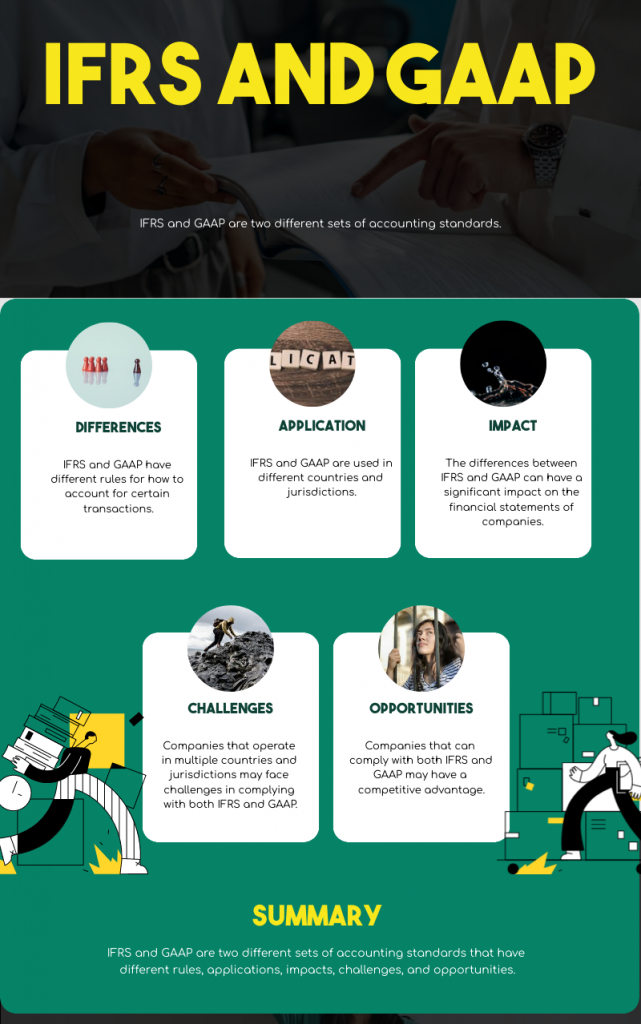
Introduction
When diving into the world of real estate fund accounting, two big names you often hear are IFRS and GAAP. These might sound like complicated financial terms, but they’re actually just sets of guidelines that help companies, including those in real estate, explain how they’re doing financially. Think of them as different recipe books for preparing financial reports – each has its own way of measuring and presenting the success of a business.
In this blog, we’re going to simplify these concepts and explore how they impact real estate fund accounting. Real estate funds are pools of money specifically used for investing in properties, and how they report their financial health can vary based on whether they use IFRS or GAAP guidelines. This variation can make a big difference in how the funds look on paper – affecting everything from their profits to their overall value.
Understanding these differences is crucial, especially if you’re an investor or part of a company dealing with real estate. The way these funds report their numbers can influence important decisions like where to invest and how to manage assets. So, let’s embark on a journey to demystify IFRS and GAAP and their roles in shaping the financial landscape of real estate funds.
Why is this important in real estate? Well, imagine a big pool of money that’s used to buy and manage properties – that’s your real estate fund. How this fund reports its financial health, like how much money it’s making or how valuable its properties are, can be quite different under IFRS and GAAP. This difference can affect everything from how attractive the fund looks to investors, to decisions about buying or selling properties. In this guide, we’ll explore how these two sets of rules impact real estate fund accounting and why it’s something worth understanding for anyone involved in property investment.
Understanding IFRS and GAAP
IFRS, governed by the International Accounting Standards Board (IASB), is a global framework that aims to bring transparency, accountability, and efficiency to financial markets. Adopted in over 140 jurisdictions, its principles-based approach offers some flexibility, allowing for interpretation based on the nature of transactions.
GAAP, primarily used in the United States, is a rule-based framework developed by the Financial Accounting Standards Board (FASB) and the Governmental Accounting Standards Board (GASB). It focuses on standardizing financial reporting to ensure consistency and comparability across entities.

Key Differences and Their Real Estate Implications
- Property Valuation: In real estate, property valuation is a critical aspect. IFRS encourages the fair value model, leading to regular revaluations that reflect current market values. This approach can cause more frequent fluctuations in reported values. GAAP, however, uses the cost model (historical cost less depreciation), providing more stable but potentially less current valuations.
- Revenue Recognition: IFRS allows revenue recognition when control of a good or service shifts, providing flexibility but also variability. GAAP’s structured, five-step process for revenue recognition can result in delayed revenue reporting, impacting how quickly a real estate transaction impacts the bottom line.
- Lease Accounting: For leases, IFRS treats all leases as finance leases, recognizing an asset and a liability on the balance sheet. GAAP distinguishes between operating and finance leases, affecting the reporting of lease expenses and liabilities.
- Expense Recognition: Under IFRS, expenses may be recognized more rapidly than under GAAP. This can significantly impact the profitability and financial position of real estate funds, especially in the early stages of property development.
Impact on Financial Reporting and Performance Metrics
The impact of IFRS (International Financial Reporting Standards) and GAAP (Generally Accepted Accounting Principles) on financial reporting and performance metrics in real estate fund accounting is significant and multifaceted. These accounting standards determine how a real estate fund’s financial health and performance are measured and reported, influencing key decisions made by investors and fund managers. Let’s break down this impact into simpler terms.
- Valuation of Properties: Under IFRS, real estate properties are often valued based on their current market value, which can change over time. This approach means that the value of the properties on the fund’s books can go up or down, reflecting the real-time market conditions. In contrast, GAAP typically sticks to the historical cost of the property, minus any depreciation. This can make the fund’s assets appear more stable over time but may not always show their true market value.
- Financial Statements: The differences in property valuation, revenue recognition, and other factors lead to distinct financial statements under IFRS and GAAP. For instance, a fund operating under IFRS might show higher asset values but also more volatility in its earnings and overall financial position, compared to a fund using GAAP. This can affect how investors and analysts view the fund’s financial health.
- Performance Metrics: Key performance indicators like Net Asset Value (NAV), Return on Investment (ROI), and earnings are directly affected by whether a fund uses IFRS or GAAP. IFRS’s market-based valuation can result in higher NAVs during market upswings but can also lead to more significant decreases during downturns. On the other hand, GAAP’s cost-based approach might show more stable but potentially lower NAVs over time.
- Revenue Recognition: IFRS and GAAP have different rules for when and how to recognize revenue from property sales or rentals. IFRS might allow a fund to record revenue earlier in a transaction, while GAAP might require more conditions to be met before recognizing this income. This can impact how soon a fund can report earnings from its properties.
- Investor Decision Making: Investors often rely on these financial reports and performance metrics when making decisions. A fund that appears more profitable or stable under one accounting standard might attract different investors compared to another standard. Understanding these nuances helps investors make more informed choices about where to put their money.
Investor Perception and Decision Making
Accounting standards play a pivotal role in shaping investor perceptions. IFRS’s fair value model, with its potential for volatility, may appeal to certain investors seeking dynamic market reflection, while GAAP’s stability in valuation might attract long-term investors. The choice of accounting standard can significantly influence investment decisions.
Compliance and Operational Considerations
Compliance with either IFRS or GAAP entails distinct challenges. The operational costs, complexity of financial reporting, and the need for specialized expertise vary, impacting how real estate funds manage their accounting practices.
Challenges in Cross-Border Investments
Cross-border investments, where funds and investors engage in real estate transactions across different countries, come with their unique set of challenges, especially when navigating between IFRS and GAAP accounting standards. These challenges significantly impact how investment opportunities are assessed and managed. Let’s delve into some of these key challenges:
- Differences in Financial Reporting: The primary challenge in cross-border investments is the difference in financial reporting standards. IFRS and GAAP have distinct approaches to valuing assets, recognizing revenue, and reporting liabilities. This divergence can lead to confusion and misinterpretation of financial statements. For instance, a property valued under IFRS might have a significantly different valuation under GAAP, affecting investment decisions and portfolio valuations.
- Comparability Issues: Investors often compare potential investments across different markets. However, the discrepancies between IFRS and GAAP can make these comparisons challenging. Identifying true like-for-like opportunities becomes difficult, potentially leading to misinformed investment decisions. This lack of comparability can deter investors from diversifying their portfolio across borders.
- Regulatory and Compliance Complexity: Each country has its own regulatory environment and compliance requirements. Navigating these alongside the differences in accounting standards adds layers of complexity. Investors and funds must be well-versed in the local regulations of each market they operate in, as well as understand how these interact with the accounting standards being used.
- Currency Fluctuations and Economic Variability: Cross-border investments inherently involve dealing with multiple currencies. Currency fluctuations can significantly impact investment returns and need to be accounted for under both IFRS and GAAP. Additionally, economic conditions can vary greatly between countries, and how these conditions are reflected in financial reporting under the different standards can influence investment decisions.
- Tax Implications: Tax regulations differ from country to country and are intricately linked to how financial activities are reported under IFRS and GAAP. Understanding the tax implications in different jurisdictions, and how these interact with the chosen accounting standard, is crucial for optimizing the tax efficiency of cross-border investments.
- Communication and Interpretation: Effective communication is vital in cross-border investments. Misinterpretation of financial information due to differences in accounting standards can lead to flawed investment strategies. Ensuring that all parties involved have a clear understanding of the financial reports, according to the relevant accounting standards, is essential for successful cross-border transactions.
The Road Ahead: Convergence or Divergence?
The ongoing debate between convergence and divergence of these standards is pivotal for the future of international real estate fund accounting. A converged global standard could simplify cross-border transactions and comparisons, but it also requires reconciling fundamentally different approaches to accounting.
CONCLUSION
In the intricate realm of real estate fund accounting, the roles of International Financial Reporting Standards (IFRS) and Generally Accepted Accounting Principles (GAAP) are both critical and distinctive. Their impact stretches far beyond mere compliance, influencing financial transparency, investor confidence, and the overall strategic decisions within the real estate sector.
The choice between IFRS and GAAP is not just a technical accounting preference, but a strategic decision that can shape a fund’s financial narrative. IFRS, with its fair value approach, offers a dynamic reflection of the market, making it appealing for those who favor current market conditions in their reporting. On the other hand, GAAP, with its emphasis on historical cost and structured revenue recognition, provides a sense of stability and consistency, particularly beneficial for long-term investment strategies.
In conclusion, the impact of IFRS and GAAP on real estate fund accounting is profound and far-reaching. Understanding and effectively navigating these standards is crucial for anyone involved in the real estate investment arena. As the industry evolves, so too will these accounting frameworks, continuing to shape the landscape of real estate fund accounting in the years to come.
Discover more from reviewer4you.com
Subscribe to get the latest posts to your email.





